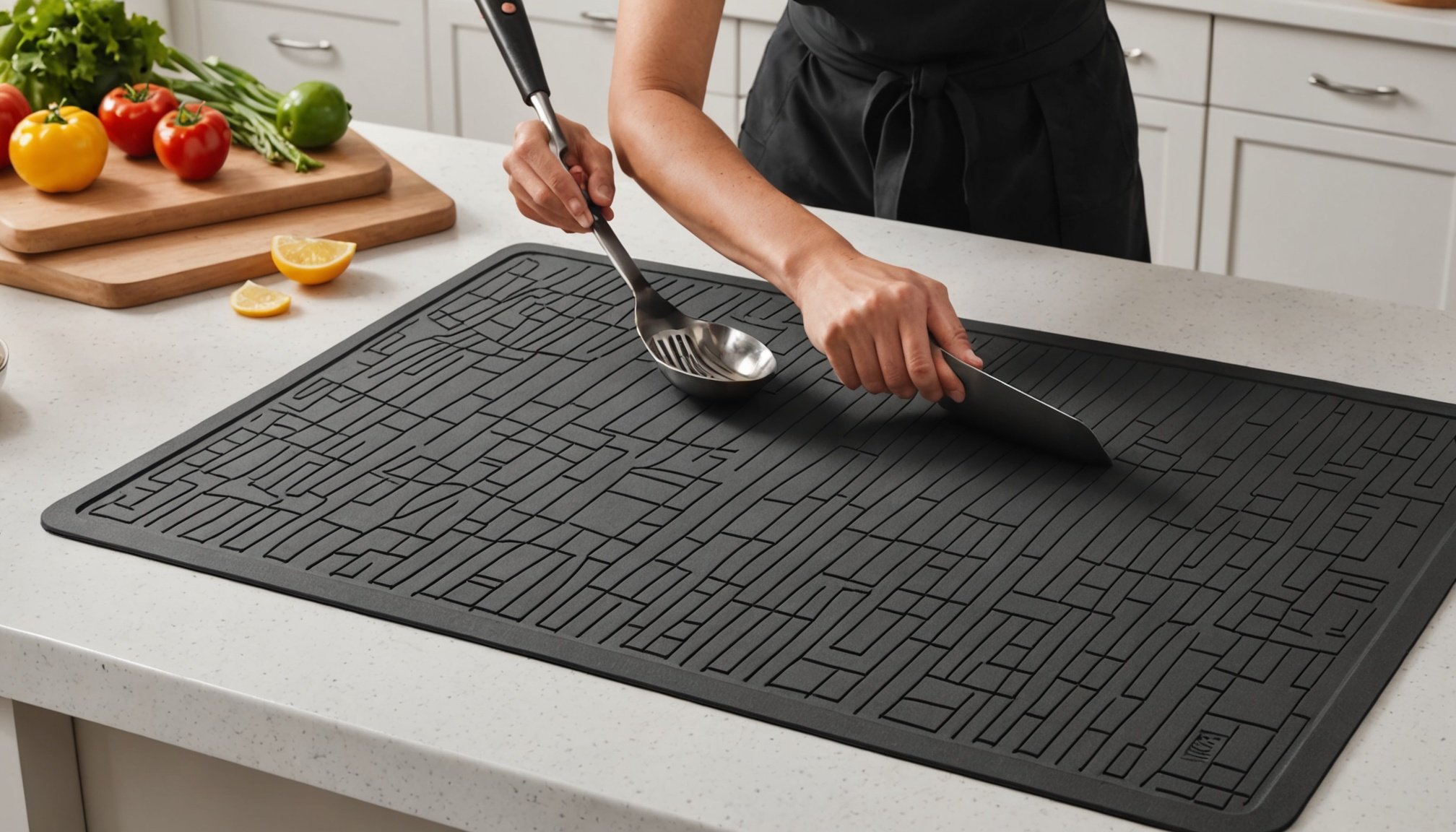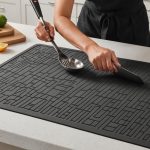Understanding Kitchen Mat Textures
Exploring different kitchen mat textures can significantly enhance your kitchen experience, especially in terms of comfort and fatigue relief. Common textures include foam, gel, and rubber, each offering distinct attributes.
Foam mats are renowned for their soft texture and cushioning effect, ideal for those who spend extensive time on their feet. The texture provides a plush surface that helps in distributing body weight evenly, alleviating pressure on joints. However, their softness can sometimes limit durability.
This might interest you : Transform your diet: discover how a programmable coffee maker with calorie tracking can enhance your wellness journey
Gel mats, on the other hand, offer superior support balance. The gel infusion provides a firm yet comfortable surface, combating fatigue through its supportive properties. This texture is particularly beneficial for individuals experiencing frequent discomfort from prolonged standing.
Rubber mats stand out due to their robust, textured surfaces. These are highly durable and often slip-resistant, making them ideal for busy kitchens. Though they may not feel as plush as foam or gel, their ergonomic texture promotes stable footing, which is crucial for prolonged tasks.
Also to read : Revitalize your weight loss journey: discover the advantages of using a meal planning whiteboard in your kitchen
Scientific studies on ergonomics underscore the importance of these textures in reducing muscle strain. By providing stability and supporting natural posture, they play a pivotal role in enhancing overall well-being. Evaluating these aspects can guide you in choosing the best texture for optimal comfort and fatigue relief.
The Role of Color in Kitchen Mats
When choosing a kitchen mat color, it’s essential to consider both aesthetics and psychological effects. Colors wield a powerful influence on mood and the overall kitchen environment. For instance, warm tones like red or yellow can often energize the space, making it feel more lively and welcoming. Conversely, cooler shades such as blue or green may evoke a sense of calm and tranquillity, perfect for those who prefer a serene cooking area.
Aesthetics play a crucial role, bringing harmony to your kitchen decor. Matching the kitchen mat color with cabinets, countertops, or kitchen appliances can create a cohesive and inviting atmosphere. For example, a kitchen with stainless steel appliances may benefit from a mat in grey tones to accentuate modern elements.
Furthermore, specific color choices can enhance the perception of cleanliness and space. Light and neutral colors such as white or beige can make a room appear larger and more open, while also giving an impression of tidiness. Darker hues, like black or navy, are excellent for hiding potential stains, which can maintain a neat appearance. Understanding these elements can help make informed decisions when selecting kitchen mats, ultimately shaping your kitchen’s ambiance.
Comparison of Kitchen Mat Materials
When exploring various kitchen mat materials, understanding their distinct properties can assist in making informed decisions.
Foam Mats
Foam mats are widely favoured for their comfort and lightweight nature. They are crafted from memory foam or polyurethane, providing a plush feel underfoot. Their durability, however, might be less impressive when compared to sturdier options, particularly in high-traffic areas. Maintenance is relatively simple; these mats need regular vacuuming and spot cleaning to prolong their lifespan. Users often highlight their comfort, though warn about potential indentations from furniture or prolonged pressure.
Gel Mats
Gel mats offer a unique combination of support and softness, often made from gel-infused layers or cores. These mats excel in pressure distribution, aiding in fatigue reduction during prolonged standing periods. They are generally durable, withstanding regular use without losing their form. Maintenance requires a simple wipe-down, making them easy to keep clean. User feedback typically emphasises their great support, though the weight can be a downside for some.
Rubber Mats
Rubber mats are renowned for their durability and resilience. Made from natural or synthetic rubber, they are perfect for busy kitchens, offering slip-resistant properties. They can withstand extensive wear and tear, ensuring long-lasting use. Maintenance involves occasional washing with mild soap, suited for environments demanding frequent cleansing. Users praise their safety features, though note that the aesthetic might not suit all kitchen designs.
Benefits of Kitchen Mats on Comfort and Fatigue Relief
Kitchen mats can significantly enhance comfort and alleviate fatigue during prolonged standing. These mats provide essential ergonomic support by reducing pressure on joints, particularly in areas such as the knees, hips, and lower back. The cushioning effect aids in minimizing strain, which is beneficial for individuals who spend a lot of time cooking or working at the counter.
Reducing Pressure on Joints
Kitchen mats effectively lessen the impact on joints, lowering the risk of discomfort or injury. By providing a softer, supportive surface, mats encourage proper posture and reduce fatigue, leading to a more comfortable experience.
Health Benefits for Specific Concerns
For those with specific health concerns such as arthritis or chronic pain, kitchen mats offer additional benefits. The ergonomic support helps in distributing weight evenly, which can mitigate the pain associated with standing on hard surfaces for extended periods.
Ergonomic Research Endorsement
Research in ergonomics supports the use of kitchen mats, highlighting their role in improving workplace safety and comfort. A better understanding of fatigue relief shows that using mats is a simple yet effective solution to enhance well-being. Emphasizing practical benefits, kitchen mats prove to be a valuable addition to any busy kitchen environment.
Tips for Choosing the Right Kitchen Mat
In selecting the perfect kitchen mat, several key factors are essential. The size of the mat is crucial to ensure it fits well in your kitchen space and provides ample area for movement. Consider measurements before purchasing to avoid placement mistakes. Equally important is the thickness of the mat; this will affect the level of cushioning and support it provides. A thicker mat generally offers more relief, especially for those standing for extended periods.
Support is integral to your comfort and health during kitchen tasks. Ensure the mat you choose offers enough ergonomic support to prevent tiredness and promote proper posture. It’s advisable to explore options that guarantee adequate foot and back support, as these will improve your overall kitchen experience.
Before finalising your purchase, investigate the trial periods and return policies. These are essential if the mat doesn’t meet your expectations in comfort or size. A flexible return policy offers you the safety to ensure your choice is right.
Additionally, look for recommendations from reputable brands, known for producing quality kitchen mats. Brands with a history of satisfied customers are often a reliable choice, offering mats known for longevity and effectiveness. Remember that investing in the right kitchen mat is investing in your daily comfort and health.
Visuals and User Testimonials
When considering the purchase of a kitchen mat, user experiences can provide valuable insights. Many customers have shared their individual stories, highlighting how specific mat styles, colours, and textures have made significant differences in their kitchen routines.
One user testimonial focuses on a floral mat design. The bright, inviting visuals transformed their kitchen aesthetic, while also providing exceptional comfort to reduce fatigue during long cooking sessions. With visual comparisons readily available, other users have pointed out the subtle yet effective details that distinguish one mat from another, such as texture and edge design.
In some case studies, kitchen mats have demonstrated considerable improvements in reducing user fatigue. A noteworthy instance was a chef who spent extensive hours standing. After incorporating a high-density foam mat with neutral colours and styles, they experienced a dramatic decrease in lower back discomfort. This showcases how crucial the right combination of design and functionality can be.
Furthermore, these user experiences underscore the importance of choosing a kitchen mat that aligns with personal preferences and needs. By examining these visuals and testimonials, potential buyers can make informed decisions, ensuring their kitchen mat not only meets but exceeds expectations in comfort and aesthetic appeal.










